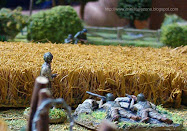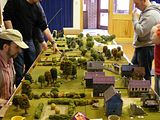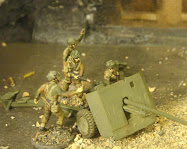This article will focus on exploitation phase of mobile operations in the PzC series. It will be narrated primarily form an attackers viewpoint. Please note that most of the information here is useful and relevant for 40+ turn scenarios or campaign games.PzC series campaign games can be divided roughly into two phases.
The first phase is the High information phase, where both sides have perfect information about each others troop dispositions, unit strengths and axis of movement/atack. This picture starts to lose coherency after approximately 15-20 turns, mostly in favor of the defender.The second phase is the Low information phase, where the defender usually monitors the attackers forces by use of withdrawing units. However the attacker loses track of some of the defenders units, especially his mobile counter attack reserves. This is the most dangerous time when the attacker tries to press his attack and achieve his objectives, AND also monitors the defenders counter attack forces concentration and movement.It is possible for the attacker to reverse, or at least alter this picture by rapid elimination of the defenders initial line of defence and starting mobile exploitation battle in enemy rear areas.
PHASE I : HIGH INFORMATION PHASE.

As I have outlined above, this phase starts with the first turn, and usually continues for the initial 15-20 turns. This is the stage where as the attacker you will have the most advantageous position. The enemy troop positions are fully within your knowledge and usually LOS, and it is possible to break through the enemy front lines with minimum delay.
There are some primary points to consider and keep in mind at this stage.
1 – Plan your assault carefully. Remember that the game you are engaged in is a long scenario. It will take from 50 to 300+ turns to play and complete this game.
Try not to allow any of your units to be completely eliminated. Even a single digit unit will recover provided it is given enough time.
2 - Before starting your assault on enemy front lines, define your assault/breakthrough forces and the exploitation forces. Prefer mobile troops, tanks, and cavalry as your exploitation force. Try as much as possible, not to engage the exploitation force in breakthrough attacks.
3- Do not push the enemy back on a broad front. Remember that time and force strength are essential for future turns. The enemy will not be in a position to lauch a counterattack in the first turns. Therefore, concentrate your infantry divisions facing the enemy front, and attack on a 3-4 hex front with full effect. Try to breach the enemy line with a <>

Once the game progresses beyond 15-20 turns, and the initial enemy stop-gap measures are disposed of, the game will enter the low information phase. From then on, you as the attacker will have limited information about enemy troop dispositions, and numerous enemy reserve formations. There are some primary points to consider and keep in mind at this stage.

PzC series provide a very good balance in each game by using default rules that simulates the conditions of that particular operation. At least I tend to think so. Here are general tips for the attacker on a title basis.
4 – Press forward with your armored units deep into the enemy’s rear area. In most scenarios this will be free of enemy units for the first 15-20 turns. If you can manage to break the initial line of defence within 5-6 turns of game commencing, this will give you 9-10 turns of free time to establish your surprise dispositions for the enemy.
5- Most players are inclined to encircle the enemy with armored units because of their rapid movement capability. In the long run this tactic allows the destruction of the great part of the enemys first line of troops. However, in doing so you are allowing your greatest assets to be tied down; namely your armored troops.
6 – Try to isolate the enemy in a loose “bag”. That is to say, do not encircle the enemy by placing units 1-2 hexes behind him. Try to use such semi-mobile units as AA guns, or AT units to form the bag, and squeeze the enemy by frontal attacks. Your armored units and the accompanying armored/motorized units need to be kept free of engagement for future employment agains enemy secondary formations and counterattacks.
7 – Since the game will provide you with a clear picture of where enemy mobile reserves are located, you will be able to guess with a high degree of accuracy about enemy counterattack directions. Keep your armored units fluid –do no use them to attack positions in enemy rear- and once the enemy counterattack starts envelop the counterattacking enemy forces in a greater “bag”. Isolated units will very rapidly become low on fuel and ammunitions, and become much easier to disrupt, allowing your units to finish them off with direct assaults.
PHASE II : LOW INFORMATION PHASE.

Once the game progresses beyond 15-20 turns, and the initial enemy stop-gap measures are disposed of, the game will enter the low information phase. From then on, you as the attacker will have limited information about enemy troop dispositions, and numerous enemy reserve formations. There are some primary points to consider and keep in mind at this stage.
1 – Bear in mind objectives, and enemy supply points. Capturing any enemy supply points will effect enemy units very adversely, and create supply level drops in enemy forces. You will begin to notice many enemy units unable to fire effectively, or move far once supply points are severed.
2 – Air recon is useful for deep reconnaissance. Use your aircraft on primary and secondary roads to detect enemy movement. Your enemy will usually prefer to use primary roads for ease of transportation and become predictable.
3 – Assign a clear objective for your maneuver elements. Use your forces with a maximum effect, and try to maneuver around the enemy. Prefer isolation over direct fire. Eventually your infantry, or mechanized infantry will catch up and allow you to clear the enemy positions.
4 – Use armored units for reconnaissance alongside with armored cars. Your forces in the enemy rear area that are free roaming are a great hazard to the enemy. They are available for isolation of enemy single units, and blocking primary roads to disrupt enemy troop movement. Once your units engage in direct firing, the enemy will know where and how strong you are. Deny knowledge to the enemy, while using your mobile troops for information gathering.
5 – Try not to use artillery or air strikes on objectives located on primary roads or road junctions. Primary roads will provide you with the infrastructure to move troops rapidly, and RUBBLE hexes on the road will slow down traffic. Engineers can clear rubble but it takes a considerable time. Try not to destroy villages, towns or cities.
GENERAL NOTES.

PzC series provide a very good balance in each game by using default rules that simulates the conditions of that particular operation. At least I tend to think so. Here are general tips for the attacker on a title basis.
Smolensk ’41 : No major terrain difficulties. No special points are noted.
Normandy ’44 : Indirect artillery fire affects all units in a hex. Take care for German artillery fire on big stacks. Open country in SE of Caen allows for mobile operations. German ability to breakdown forces to a great extent allows the use of littering tactics.
Kharkov ’42 : No major terrain difficulties. No special points are noted.
Tobruk ’41 : No experience in the title. I will refrain from comments for this title.
Bulge ’44 : Short day turns. Do NOT reduce anything on the map to rubble; especially villages/towns on primary roads. Terrain favors the attacker, once you establish your objectives dig in. The counter-attacker will have a tough time digging you out.
Korsun ’44 : Strong German panzer divisions relative to Soviet forces. German ability to breakdown forces to a great extent allows the use of littering tactics. Try to isolate and destroy German infantry in order to force Panzer divisions to hold front lines.
Kursk ’43 : Great German quality superiority. Try to use tanks in stacks. Units gain relatively less fatigue when compared to other titles because of unit sizes. Try to prefer direct fire instead of assaults, since Soviet numbers begin to tell after 50+ turns.
Sicily ’43 : No experience in the title. I will refrain from comments for this title.
Rzhev’42 : Storm conditions work both ways. If you can manage to break through the German initial line of defense, try to use your T-34s fluidly, and isolate enemy rear are units. Remember movement is as hard for the enemy as it is for you. Force your enemy to move.
Market Garden ’44 : Capturing Nijmegen bridges is the key to victory. Try to use the minimum force necessary to defend supply points near Grosbeek heights, and cross the river at Nijmegen immediately. With the 1st Para, try to get inside Arnhem, and stop German reinforcement movement. Preventing German forces from moving troops to Nijmegen will grant victory.
El-Alamein ’42: The optional rules allow for armored units to move between enemy units by spending a full movement point. Germans have relatively few armored units. Force German armored units to react to your probes in the line, and once they are eliminated as a coherent force, isolate line infantry.
France ’40 : No experience in the title. I will refrain from comments for this title.
Salerno ’43 : No experience in the title. I will refrain from comments for this title.
Moscow ’41 : No experience in the title. I will refrain from comments for this title.
Stalingrad ’42 : Cavalry forces preserve their movement rates. Use the wisely to isolate German units. Destroy the Rumanian units and get into German units rear in order to force them to abandon their bunkers. Bridges at Kalach are a primary objective since they control primary roads running to Stalingrad. Try to force Germans to keep a maximum force in Stalingrad by repeated attacks in the city.
Budapest ’45: German/Hungarian units holding the line are very weak. Try to break their lines and isolate them before they can withdraw. The primary roads are crucial, and your force quality is on par with Germans. Destroy the initial line, and move your infantry up the 3 primary roads available. Establish your units before assaulting the city. Do not commit them piecemeal to battle.
Minsk ’44 : No experience in the title. I will refrain from comments for this title.I hope you find some of the above useful in your games.
Good hunting. !




















































No hay comentarios:
Publicar un comentario